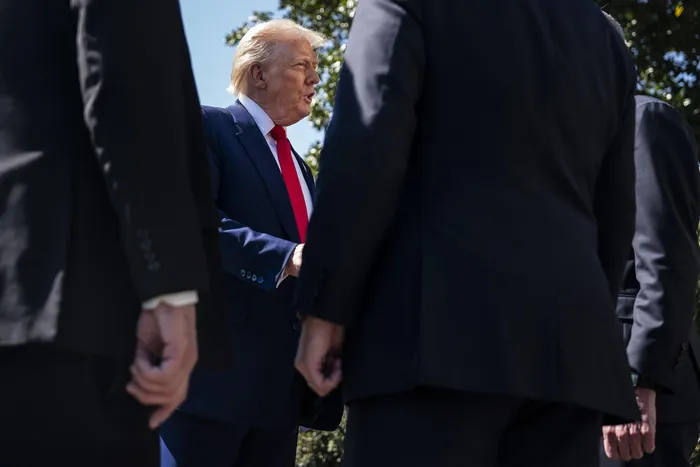Trump announces tariffs of at least 25% on 14 countries

President Donald Trump speaks at the White House on April 9 after announcing a 90-day pause on some tariffs. That pause is now expiring.
Image: Jabin Botsford/The Washington Post
President Donald Trump on Monday threatened tariffs between 25% and 40% on imports from 14 countries, including Japan, South Korea, Thailand and Bangladesh, the first of what he said would be a series of higher duties as the administration continues negotiating trade deals ahead of a new Aug. 1 deadline.
In a string of near-identical letters posted on Truth Social, his social media site, Trump said the United States “has agreed to continue working with” each country despite large trade deficits.
“Our relationship has been, unfortunately, far from Reciprocal,” he wrote, adding that the proposed tariffs are just a starting point. “ … If for any reason you decide to raise your Tariffs, then, whatever the number you choose to raise them by, will be added” to the country’s import fees.
The new tariffs released Monday are strikingly similar to the “Liberation Day” levies Trump announced in April, and would begin at 25% for Japan, South Korea, Malaysia, Kazakhstan and Tunisia; and go as high as 40% for Myanmar and Laos. Meanwhile, South Africa, Bosnia, Indonesia, Bangladesh, Serbia, Thailand and Cambodia would face tariffs between 30% and 36%.
“The president is determined to light a fire under those trading partners who he thinks are not moving fast enough,” said Wendy Cutler, the vice president of the Asia Society Policy Institute and a former US trade negotiator. “But to hit two of our closest allies [Japan and South Korea] with high tariffs - particularly when we have benefited from cooperation with them on semiconductors and energy and chip building, and when their companies invest a lot in the United States - it is hard for me to circle the square here.”
Cutler said she was particularly surprised by the measures against South Korea, which has had a free trade agreement with the United States since 2012 that the new tariffs would violate. Trump has long criticized the alliance, calling it a “job-killing trade deal” during his first campaign. His willingness to go after a longtime trading partner, Cutler said, signals a bigger shift in US trade policy.
“This certainly calls into question the value of a free trade agreement with the United States,” she said.
The administration’s 90-day pause on tariffs that Trump rolled out in April - ranging from 10% to about 50% on imports from dozens of countries - is set to lift Wednesday, though Trump issued an executive order later Monday delaying that date to Aug. 1.
“If you wish to open your heretofore closed Trading Markets to the United States, and eliminate your Tariff, and Non Tariff, Policies and Trade Barriers, we will, perhaps, consider an adjustment to this letter,” Trump wrote.
Economists, business owners and foreign officials struggled to interpret the onslaught of new tariff proposals Monday. It was unclear, they said, whether the administration was serious in its plans or just hoping to jump-start stalled conversations, though both scenarios added to mounting economic uncertainty.
“There’s this enormous threat, but it’s like he doesn’t want to squeeze the trigger,” Marcus Noland, executive vice president and director of studies at the Peterson Institute for International Economics, said of Trump. “He keeps extending the deadline to give people time to make a deal. Whether or not this is another bluff, it certainly leaves things unsettled.”
Treasury Secretary Scott Bessent on Sunday said the tariff letters were a way to encourage other countries to “move things along” in trade negotiations. “I think we’re going to see a lot of deals very quickly,” he said on CNN’s “State of the Union.”
Despite the administration’s repeated assurances that it is close to negotiating major trade agreements, deals have been slow to materialize. Last week, Trump said on social media that he had reached a trade agreement with Vietnam, including a 20% tariff on the country’s imports, though details remain fuzzy.
White House press secretary Karoline Leavitt told reporters Monday that the president’s tariffs are aimed at fixing trade imbalances that have cut into US manufacturing.
“He is literally looking at the map and looking at every country on the planet and seeing where they are ripping off the American people, seeing where they have hollowed out our industrial base, seeing where our jobs have gone to other countries overseas because of their tariff policies, and he’s trying to correct that,” Leavitt said.
Still, investors are on edge, with all three major stock indexes falling as the new trade announcements rolled out. Each ended the day down less than 1 percent, though.
“You just don’t know what [Trump’s] going to do tomorrow, and that’s what’s scaring the markets,” said Desmond Lachman, a senior fellow at the American Enterprise Institute, a Washington think tank. “Even if all of this gets rolled back, there’s going to be a price for the economy.”
WASHINGTON POST